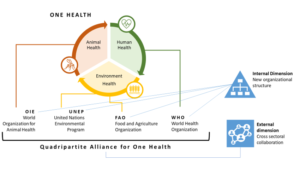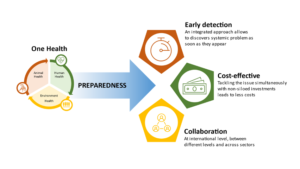One Health has been a true paradigm shift in the health sector, as it entails overcoming the old siloed mentality and moving towards a cross-cutting approach focused on the interactions between humans, animals, and the environment. An example of its importance is the agri-food system: crop fields expansion over forests leads to the cohabitation in the same area of wild animals and humans, with an increased risk of disease transmission by feces contamination or through vectors such as ticks and mosquitoes. Again, gathering the products of the forest – as well as hunting and eating wild animals – may result in an infection due to an animal pathogen; finally the crowdedness in animal farming has been an important premise of many epidemics spilled over to humans.
One health approach and international organizations
This integrated approach was one of the core topics discussed during the 2022 conference of the Geneva Health Forum (GHF), a forum created by University institutions in Geneva that brings together experts and stakeholders “to help find solutions to global health challenges”. The rising attention to the One Health approach is not surprising, as the current pandemic emphasizes the concepts One Health builds on the collective need for more sustainable development, preparedness for future shocks, and sound partnership to ensure more comprehensive health.
In the Geneva Health Forum, the twofold nature of One Health has also been addressed: on the one hand, institutions and organizations can implement it at an external level through cooperation between stakeholders operating in different fields; on the other hand – at an internal level – there is a trend towards the formulation of integrated policies and the redesigning of organizational structures (GHF 2022a). As a result, One Health is articulated across sectors and policies, tackling issues like neglected tropical diseases, antimicrobial resistance, collaborative capacity-building, and education.
Regarding cooperation among key actors, it is worth mentioning that in 2022 the UN Environment Program (UNEP) joined WHO, FAO, and OIE1 in what formally became the Quadripartite Alliance of international organizations advocating for One Health. The Joint Plan of Action elaborated by the Alliance in 2022 aims at mainstreaming the approach at all levels, at catalyzing change through cross-sectoral action and at fostering transversal investments (WHO 2022a).
When it comes to the internal level, it must be noted that each one of the aforementioned organizations is working on its internal structure to “break the silos” and bring together experts belonging to different sectors, such as climate change, public health, and mosquito-borne diseases.

One Health and pandemic preparedness
Implementing a One Health governance structure, both at the internal and at the external level, seems to be crucial also when it comes to pandemic preparedness. It is clear that to tackle emerging health challenges it is necessary to address the human, animal, and environmental dimensions simultaneously (GHF 2022b). What emerged from the Geneva Health Forum is that – on the most basic level – One Health is promoting preparedness: when One Health is transposed from principle to action, it entails early planning and collaboration mechanisms to face a vast array of human-animal-environment risk factors.
An example in this sense comes from the fight against neglected tropical diseases, a group of pathologies – primarily affecting tropical areas – which are often vector-borne and very dependent on environmental factors such as global warming, resource exploitation, and pollution. In the Roadmap for neglected tropical diseases 2021 – 2030, the WHO highlighted the importance of considering the environmental and animal dimensions, for instance, by studying how the impact of climate change will increase the spread of animals such as mosquitoes and snakes.
Furthermore, a One Health sensitive organizational structure – permeable to prompts from other sectors – can detect earlier and respond better to health challenges. Moreover, working together with specialized partners reduces the duplication of work, eventually leading to a more efficient allocation of time and money. In other words, One Health projects address the issue through a single plan; this happens also because, given their transversal nature, they can benefit from diversified investments. By contrast, a step-by-step siloed approach is likely to fail as human health challenges can be categorized as “wicked problems”: problems with components so tangled that to tackle a single aspect it is necessary first of all to face other problems, making them very difficult to solve.
The concept One Health is furthermore interesting if we look at the “silent pandemic” of drug-resistant pathogens, with an impact on human health larger – for instance – than the AIDS epidemic. The link with animal health becomes clear, considering that animals in industrial farms are among the major recipients of antibiotics and could potentially act as springboards for human drug-resistant infections (GHF 2022c).
The link between pandemic preparedness and One Health has been discussed in the seventy-fifth World Health Assembly, from the 22nd to the 28th of May (WHO 2022b). The importance of working on animals and the environment to effectively control zoonotic and vector-borne diseases will be in the spotlight because it is likely that the next pandemics will originate from animals, as was the case of Covid-19 and similarly to what is happening in these days with monkeypox. The approach is also playing a key role in the ongoing negotiations for a “pandemic treaty” to foster preparedness, and to strengthen the collaboration between States.

International, cross-level, and cross-sectoral collaboration
International cooperation is very important: One Health is an international challenge because zoonotic and vector-borne diseases, climate change, and even human health easily cross national borders. The “pandemic treaty” currently discussed by the World Health Assembly and the One Health Joint Plan of Action developed by the Quadripartite Alliance (2022) represent an opportunity to build a governance framework. This result is useful not mainly for decision-making, which is up to the health authorities of Member States, but to share data and provide technical and political guidance and foster capacity building.
The role of One Health in the “pandemic treaty” highlights the importance of collaboration across sectors at all levels to ensure an equal access to a healthy life. But while international collaboration has proven pivotal in tackling global challenges such as a pandemic, collaboration at all levels and across levels is equally fundamental as it addresses the causes of such challenges.
Cooperating with local communities and the private sector is a key element for a sound implementation of the One Health approach (GHF 2022a): local communities have a more direct control on the natural capital and the ecosystem services ensuring a healthy life. Moreover the local level is well-suited for screening and monitoring emerging challenges, and private companies often have the knowledge and the capacity to develop and deploy integrated solutions which can become a new benchmark for One Health projects.
Finally, cross-sectoral collaboration is crucial to tackle the same issue simultaneously and from different perspectives, creating an integrated framework for action. Cross-sectoriality must be extended to the financial sector (GHF 2022d), trying to overcome the “siloed” investments. Another key sector that should implement the One Health framework is education (GHF 2022e): schools and universities should promote an integrated approach to health, implementing it in their curricula and supporting academic research on the topic.
Sources
- GHF (2022a), One Health: is there a paradigm shift?, 3 May 2022.
- GHF (2022b), Pandemic Preparedness and Response Implications for Global Health Governance, 4 May 2022.
- GHF (2022c), Achieving sustainable antibiotic access using a One Health approach, 3 May 2022.
- GHF (2022d), The private sector as a key player in the operationalization of the One Health concept, 5 May 2022.
- GHF (2022e), What training should we build for One Health planetary health, 4 May 2022.
- Quadripartite Alliance (2022), One Health Joint Plan of Action, 2022.
- WHO (2021), Roadmap for neglected tropical diseases 2021 – 2030, 28 January 2021, p. 165.
- WHO (2022a), Quadripartite Memorandum of Understanding, 29 April 2022.
- WHO (2022b), Strengthening WHO preparedness for and response to health emergencies, 6 May 2022.